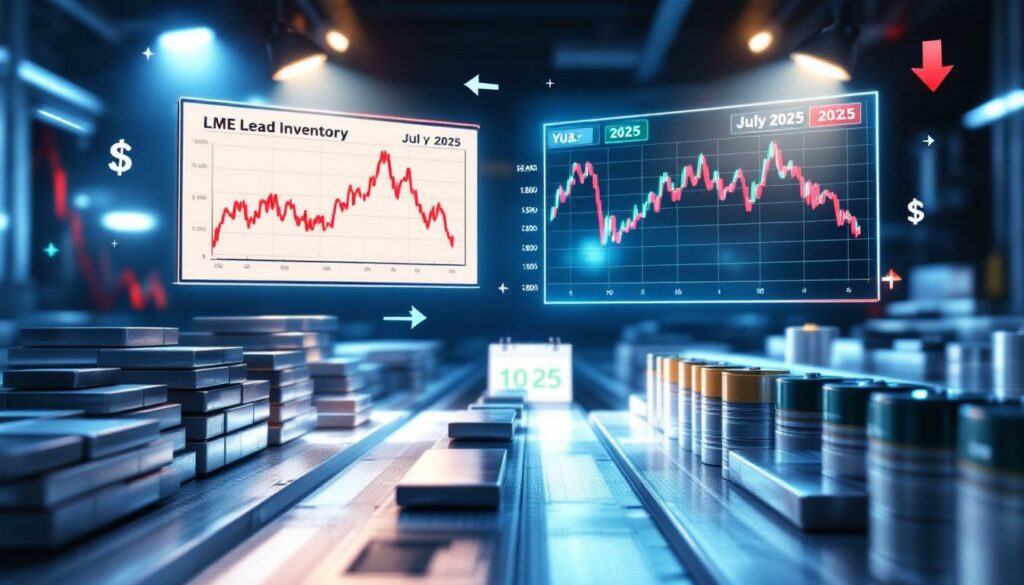Lead Market Dynamics: Raw Material Supply and Consumption Expectations in 2025
The global lead market is currently navigating a complex interplay between supply fundamentals and demand expectations, creating both challenges and opportunities for market participants. With key macroeconomic developments unfolding alongside seasonal market patterns, understanding the current landscape requires careful analysis of multiple factors affecting this critical industrial metal.
What Factors Are Influencing Lead Prices in the Current Market?
The lead market is experiencing significant pressure from both macroeconomic forces and market-specific dynamics that are creating a complex pricing environment in mid-2025.
Macroeconomic Forces Shaping the Lead Market
The global economic landscape continues to exert considerable influence on lead prices. Most notably, the U.S. tariff policy impact expected by July 9, 2025, has created uncertainty in metals markets. These potential trade policy changes come at a time when market participants are already digesting stronger-than-expected U.S. economic data.
Recent U.S. non-farm payrolls exceeded analyst expectations, signaling continued economic resilience despite earlier concerns about slowdown risks. This economic strength has significantly reduced expectations for Federal Reserve interest rate cuts in July, with market pricing now indicating high interest rates will likely persist through the second half of 2025.
"The recent in-the-doldrums performance of the U.S. dollar index has provided certain opportunities for base metals, including lead, despite the challenging high-rate environment," notes the SMM Analysis Team.
While high rates typically pressure commodity prices, the weakening U.S. dollar has created a counterbalancing force, as dollar-denominated metals become relatively less expensive for buyers using other currencies.
LME Lead Market Dynamics
London Metal Exchange (LME) lead inventories have declined noticeably, dropping by over 10,000 metric tons to reach 263,000 mt as of early July 2025. This inventory reduction coincides with a widening LME lead cash-to-three-month contango, which has expanded to -$26.47/mt.
The contango structure (where future prices exceed spot prices) typically signals near-term oversupply, yet prices have remained resilient due to:
- Growing seasonal consumption expectations in overseas markets
- Tightening physical concentrate availability
- Increasing lead recycling costs
Based on these factors, SMM analysts project a trading range of $2,030-$2,090/mt for LME lead in the coming week, reflecting the market's attempt to balance contradictory signals.
How Are Supply and Demand Factors Creating Market Contradictions?
Lead market participants currently face a puzzling scenario where traditional supply-demand indicators appear misaligned, creating unusual market behavior and pricing signals.
Raw Material Supply Challenges
The lead concentrate and secondary (recycled) markets are experiencing increasing cost pressures. Demand for both primary lead concentrates and scrap batteries has intensified, driving raw material costs higher and creating a price floor for refined lead.
This cost-push inflation is particularly evident in the recycling sector, where a recent battery recycling breakthrough could eventually impact the market. Currently:
- Battery collection networks are reporting tighter supply
- Processing costs have increased due to environmental compliance requirements
- Competition for available scrap has intensified between secondary smelters
"The persistent strength in raw material costs continues to provide fundamental support for lead prices despite the complex demand picture," according to SMM market analysts.
However, the supply side presents a contradiction: while raw material costs suggest tight supply, actual refined lead production is poised to increase. Multiple smelters have completed maintenance cycles, and new capacity is scheduled to come online in July. This supply growth is materializing earlier than the anticipated consumption increase, creating a temporal mismatch in the market.
Consumption Pattern Complexities
On the demand side, equally contradictory signals exist. The lead-acid battery market—representing approximately 80% of global lead consumption—has not yet entered its true peak season. This delayed seasonal uptake comes as high lead prices constrain downstream procurement enthusiasm.
Battery manufacturers are displaying cautious buying behavior, characterized by:
- Reduced order sizes
- "Hand-to-mouth" purchasing strategies
- Postponed inventory rebuilding
The financial incentive for this caution is clear in the futures-spot price relationship. The spread between futures and spot prices has widened to over 200 yuan/mt, creating both arbitrage opportunities and purchase hesitation.
A particularly important technical factor is the potential conversion of unreported inventory to reported inventory. When prices reach certain thresholds, previously invisible stocks may emerge, affecting price momentum ahead of futures delivery dates.
What Is the Outlook for China's Domestic Lead Market?
China's lead market outlook reflects both supply expansion and cautious demand expectations, creating a nuanced price forecast for the near term.
SHFE Lead Price Projections
The Shanghai Futures Exchange (SHFE) lead market is expected to trade within a defined range in the coming weeks. SMM analysts project:
- Most-traded contract range: 17,050-17,450 yuan/mt
- Spot price forecast: 16,950-17,200 yuan/mt
- Maintenance of contango trading in spot lead markets
This pricing outlook reflects China's unique position as both the world's largest lead producer and consumer, with domestic dynamics often diverging from international trends.
Supply-Side Developments
China's supply picture is shifting as July progresses. Key developments include:
- Primary and secondary lead enterprises resuming normal operations after scheduled maintenance
- New production capacity expected to come online during July
- Increasing expectations for refined lead supply growth
These supply expansions are occurring at a time when downstream demand has not yet reached its seasonal peak, creating potential imbalances in the short term.
The capacity additions represent part of China's ongoing shift toward more efficient, environmentally compliant lead production facilities, but their timing relative to demand cycles creates market complications.
Demand-Side Factors
On the consumption side, several developments are worth monitoring:
- Lead-acid battery manufacturers have completed their year-end inventory checks and financial settlements
- Production lines are gradually returning to normal operations
- Procurement departments are cautiously resuming regular material purchasing
- Traditional peak season expectations are building but not yet fully materialized
The critical timing mismatch highlighted by SMM analysts is that "supply increases are likely to precede consumption growth," creating a potential oversupply window before peak battery production season fully activates.
How Are Seasonal Patterns Affecting the Lead Market?
Lead markets traditionally follow well-established seasonal patterns, but the current market exhibits unusual timing dynamics that require careful analysis.
Transitional Market Phase Indicators
The lead market is currently in a transitional phase characterized by:
- Completion of June end-of-quarter settlements and inventory checks
- July marking the beginning of production normalization across the supply chain
- Approach of the traditional consumption peak season, which typically begins in August
- Cautious procurement strategies amid a high price environment
This transitional period creates a window where market psychology plays a crucial role in price formation. Expectations of future demand can support prices even before actual consumption materializes, particularly when raw material costs provide a price floor.
"The lead market is balancing between the reality of current demand and the anticipation of peak season requirements, creating a precarious equilibrium in pricing," explains the SMM Lead Market Forecast.
Inventory Management Considerations
A key factor during this transitional period is inventory positioning throughout the supply chain. Several critical considerations include:
- Potential conversion of unreported to reported inventory as prices fluctuate
- Impact on lead price increase momentum before the next futures delivery
- Strategic positioning by market participants ahead of seasonal shifts
Historically, lead markets have seen significant price corrections when unreported inventories suddenly appear in official warehouses, often triggered by specific price thresholds or technical market signals.
Battery manufacturers typically begin building inventory 6-8 weeks before their production peak, suggesting that early signals of the true seasonal demand surge should become visible by late July to early August if patterns follow historical norms.
What Are the Key Market Signals to Monitor?
For market participants navigating this complex lead market environment, several critical signals deserve close attention in the coming weeks.
Price Support Mechanisms
Three primary factors currently provide price support for lead:
1. Raw Material Cost Inflation
- Rising lead concentrate prices establishing a production cost floor
- Increasing scrap battery collection and processing costs
- Environmental compliance expenses adding to overall production costs
2. Seasonal Consumption Expectations
- Psychological support from anticipated battery demand growth
- Historical patterns suggesting imminent consumption increases
- International market seasonal trends providing sentiment support
3. Currency Effects
- Weakening U.S. dollar providing some upward momentum for all base metals
- Reduced dollar-denominated costs for non-U.S. buyers
- Relative currency movements affecting regional competitiveness
Potential Price Pressure Points
Despite these supportive factors, several elements could exert downward pressure on lead prices:
1. Supply-Demand Timing Mismatch
- Supply increases outpacing demand growth in the near term
- New production capacity coming online before peak consumption
- Post-maintenance production resumption creating temporary oversupply
2. Market Technical Factors
- Widening futures-spot price spread (over 200 yuan/mt) encouraging arbitrage
- Potential for unreported inventory to convert to reported inventory
- Delivery date dynamics affecting short-term market positioning
3. Downstream Purchasing Behavior
- Procurement hesitancy at elevated price levels
- "Hand-to-mouth" buying strategies limiting inventory building
- Cautious approach to long-term commitments amid economic uncertainty
The contradiction between raw material supply and consumption expectations for lead remains a key challenge for market participants, as commodity price pressures continue to influence strategic decisions across the value chain. Furthermore, ongoing metal price trends suggest that lead markets may follow broader patterns seen in other industrial metals as industry evolution insights point to structural changes ahead.
FAQ: Lead Market Outlook
How might U.S. monetary policy affect lead prices in H2 2025?
The continuation of high interest rates in the U.S. through the second half of 2025 creates significant headwinds for base metals including lead. High rates increase financing costs for inventory holding, strengthen the dollar (typically negative for commodity prices), and generally reduce economic growth expectations.
However, these effects may be partially offset by the weakening U.S. dollar index, which provides some support for dollar-denominated commodities like lead. Market participants should monitor Federal Reserve communications closely for signals about potential rate trajectory changes.
What is driving the contradiction between supply and consumption expectations?
The contradiction stems from supply growth (resumption of production and new capacity) materializing ahead of the traditional consumption peak season. This timing mismatch creates a temporary imbalance that affects market sentiment and price formation.
Additionally, the gap between raw material costs (which are rising) and end-product demand (which remains cautious) creates unusual market dynamics where producers face margin pressure despite potentially adequate supply. This contradictory environment typically resolves once seasonal demand patterns fully materialize, but the interim period creates volatility and uncertainty.
How are battery manufacturers responding to current lead price levels?
Battery manufacturers are showing restrained procurement enthusiasm due to high lead prices, preferring to wait for more favorable price levels or clearer signals of peak season demand before committing to larger purchases.
This cautious approach manifests as:
- Reduced order sizes with more frequent purchases
- Delayed inventory rebuilding despite approaching peak season
- Utilization of existing inventory to bridge production needs
- Increased price negotiation and contract flexibility requests
The wide futures-spot spread also creates incentives for downstream buyers to delay purchases when possible, as the market structure suggests potential price moderation in the near term.
Disclaimer: This market analysis contains forward-looking statements and projections based on current market conditions. Actual market developments may differ significantly from these projections due to various factors including economic policy changes, unexpected supply disruptions, or demand fluctuations. This analysis should not be considered investment advice, and market participants should conduct their own due diligence before making trading decisions.
Ready to Stay Ahead of Major Mineral Discoveries?
Discover how Discovery Alert's proprietary Discovery IQ model delivers instant notifications on significant ASX mineral discoveries, giving you a crucial edge in the market. Visit our discoveries page to see historical examples of exceptional returns and begin your 30-day free trial today.




